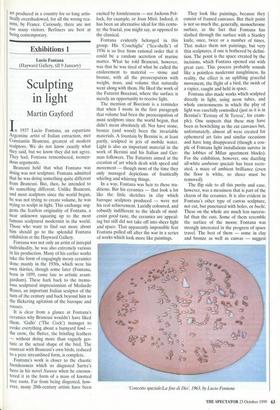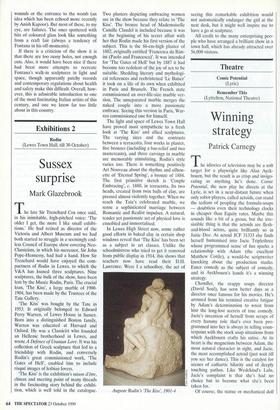Exhibitions 1
Lucio Fontana (Hayward Gallery, till 9 January)
Sculpting in light
Martin Gayford
In 1937 Lucio Fontana, an expatriate Argentine artist of Italian extraction, met Constantin Brancusi, greatest of modern sculptors. We do not know exactly what they said, but we know they did not agree. They had, Fontana remembered, tremen- dous arguments.
Brancusi held that what Fontana was doing was not sculpture. Fontana admitted that he was doing something quite different from Brancusi. But, then, he intended to do something different. Unlike Brancusi, and most sculptors since the world began, he was not trying to create volume, he was trying to sculpt in light. This exchange sug- gests the fearless originality of Fontana, a near unknown squaring up to the most famous sculptural modernist in the world. Those who want to find out more about him should go to the splendid Fontana exhibition at the Hayward Gallery.
Fontana was not only an artist of intrepid individuality, he was also extremely various in his production. Many of his earlier works take the form of engagingly messy ceramics done mainly in the 1930s, which were his own thirties, though some later (Fontana, born in 1899, came late to artistic avant- gardism). These hark back to the tremu- lous sculptural impressionism of Medardo Rosso, an important Italian sculptor of the turn of the century and back beyond him to the flickering agitation of the baroque and rococo.
It is clear from a glance at Fontana's ceramics why Brancusi wouldn't have liked them. 'Gallo' ('The Cock') manages to evoke everything about a barnyard fowl the crow, the flutter, the bristling feathers — without doing more than vaguely ges- ture at the actual shape of the bird. The contrast with Brancusi's own birds, reduced to a pure streamlined form, is complete. Fontana's work is closer to the chaotic formlessness which so disgusted Sartre's hero in his novel Nausea when he encoun- tered it in the form of a mass of knotted tree roots. Far from being disgusted, how- ever, many 20th-century artists have been excited by formlessness — see Jackson Pol- lock, for example, or Joan Mire. Indeed, it has been an alternative ideal for this centu- ry: the fractal, you might say, as opposed to the classical.
Fontana evidently belonged in this group. His 'Conchiglie' ('Sea-shells') of 1936 is so free from rational order that it could be a random accretion of marine matter. What he told Brancusi, however, was that he was tired of what he called the enslavement to material — stone and bronze, with all the preoccupation with weight, mass, and volume that naturally went along with them. He liked the work of the Futurist Boccioni, where the surface is merely an opportunity to receive light.
The mention of Boccioni is a reminder that when I wrote in the first paragraph that volume had been the preoccupation of most sculptors since the world began, that didn't mean absolutely all. Nor have stone, bronze (and wood) been the invariable materials. A fountain by Bernini is, at least partly, sculpted in jets of mobile water. Light is also an important material in the work of Bernini and his Italian and Ger- man followers. The Futurists aimed at the creation of art which dealt with speed and movement — though most of the time they only managed depictions of frantically whirling and whirring things.
In a way, Fontana was heir to these tra- ditions. But his ceramics — that look a lot like the little sketches in clay which baroque sculptors produced — were not his real achievement. Luridly coloured, and robustly indifferent to the ideals of mod- ernist good taste, the ceramics are appeal- ing but still did not take off into sheer light and space. That apparently impossible feat Fontana pulled off after the war in a series of works which look more like paintings.
They look like paintings, because they consist of framed canvases. But their point is not so much the, generally, monochrome surface, as the fact that Fontana has slashed through the surface with a Stanley knife, once, twice or a number of times. That makes them not paintings, but very thin sculptures, if one is bothered by defini- tion. The point is the space created by the incisions, which Fontana opened out with great care. This process probably sounds like a pointless modernist naughtiness. In reality, the effect is an uplifting graceful movement, the flight of a bird, the swish of a rapier, caught and held in space.
Fontana also made works which sculpted directly in light, using neon tubes, and whole environments in which the play of light was carefully controlled (just as it is in Bernini's 'Ecstasy of St Teresa', for exam- ple). One suspects that these may have been as bewitching as the cut canvases but, unfortunately, almost all were created for ephemeral art fairs and similar occasions and have long disappeared (though a cou- ple of Fontana light installations survive in the lobbies of Milan apartment blocks). For the exhibition, however, one dazzling all-white ambience spaziale has been recre- ated, a maze of ambient brilliance (even the floor is white, so shoes must be removed).
The flip side to all this purity and ease, however, was a messiness that is part of the charm of the ceramics. It is also evident in Fontana's other type of canvas sculpture, not cut, but punctured with holes, or buchi. These on the whole are much less success- ful than the cuts. Some of them resemble the surface of the moon; Fontana was strongly interested in the progress of space travel. The best of them — some in clay and bronze as well as canvas — suggest
'Concetto spazialelLa fine di Dio, 1963, by Lucio Fontana wounds or the entrance to the womb (an idea which has been echoed more recently by Anish Kapoor). But most of these, to my eye, are failures. The ones spattered with bits of coloured glass look like something from a craft fair (always a tendency of Fontana in his off-moments).
If there is a criticism of the show it is that there are too many holes, not enough cuts. Also, it would have been nice if there had been more attempts to recreate Fontana's walk-in sculptures in light and space, though apparently patchy records and contemporary regulations about health and safety make this difficult. Overall, how- ever, this is admirable introduction to one of the most fascinating Italian artists of this century, and one we know far too little about in this country.



















































































 Previous page
Previous page